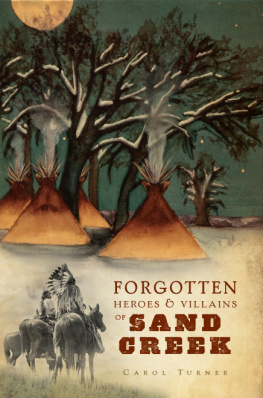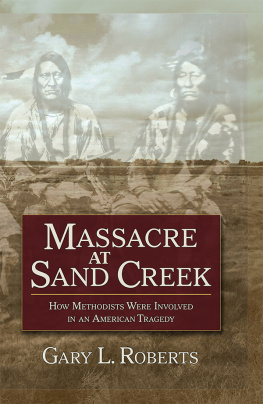
The Three Battles of
S AND C REEK
In Blood, in Court, and as the End of History
Gregory F. Michno
2017 by Gregory F. Michno
All rights reserved. No part of this publication may be reproduced, stored in a retrieval system, or transmitted, in any form or by any means, electronic, mechanical, photocopying, recording, or otherwise, without the prior written permission of the publisher.
First Edition, first printing
Library of Congress Cataloging-in-Publication Data
Names: Michno, Gregory, 1948-author.
Title: Three battles of Sand Creek: In Blood, in Court, and as the End of History / by Gregory F. Michno.
Description: First edition. | El Dorado Hills, California: Savas Beatie LLC, 2017. | Includes bibliographical references and index.
Identifiers: LCCN 2016019329| ISBN 9781611213119 (hardcover : alk. paper) | ISBN 9781611213126 (ebk.) | ISBN 9781611213126 (Mobi)
Subjects: LCSH: Sand Creek Massacre, Colo., 1864. | Cheyenne Indians--Wars, 1864. | Arapaho Indians--Wars.
Classification: LCC E83.863 .M533 2017 | DDC 978.8004/97353--dc23
LC record available at https://lccn.loc.gov/2016019329

Published by
Savas Beatie LLC
989 Governor Drive, Suite 102
El Dorado Hills, CA 95762
Phone: 916-941-6896
Web: www.savasbeatie.com
E-mail:
Savas Beatie titles are available at special discounts for bulk purchases in the United States by corporations, institutions, and other organizations. For more details, please contact Savas Beatie, P.O. Box 4527, El Dorado Hills, CA 95762, or you may e-mail us at for additional information.
History is a pack of lies we play on the dead.
Voltaire (1694-1778)
Preface
After spending nearly half a century studying the western Indian wars, I finally achieved a sense of enlightenment, that moment when the little Eureka light bulb pops on and a richer and fuller understanding is achieved. Ironically, this milestone of sorts also produced a dichotomy, because it has finally become clear that there are no definitive answers to be realized. It is extremely difficult to write accurate history. Studying and writing good history on Sand Creek is nearly impossible.
Others have already written extensively on the Sand Creek incident. I use the word incident because the words fight, battle, or massacre more often than not spark an argument before a discussion on the merits even begins. Almost every major historical event experiences interpretive shifts over the years. Examples abound, such as the causes of Civil War, Custers actions at the Battle of the Little Bighorn, or the depiction of the American Indian.
The manner in which Sand Creek has been portrayed, however, has remained remarkably static. Politicians, investigative committees, and the Eastern press hailed it as a massacre almost from the start, and most of the general public today who hears the words Sand Creek add the word massacre to the end. The only good press about Sand Creek came from a few eyewitnesses, but they are usually depicted as apologists or liars. Even some of those men changed their minds when the tide of disgust grew too high to withstand. The Sand Creek affair was a tragic event in American history, but after all the ink spilled writing about it, we still dont know what really happened beyond the most general brush strokes.
Many questions arise when discussing Sand Creek: Were the Indians peaceful? Did they capture and hold white prisoners? Were they under the protection of the soldiers? Was this a battle or a massacre? Were excessive numbers of women and children killed? Were bodies mutilated? Did the Indians fly an American flag? Did the chiefs die stoically in front of their tipis? Were white scalps found in the village? Did Sand Creek trigger the beginning of the extensive and bloody Indian Wars?
Three formal hearings were conducted to find answers to these and other questions. The body of evidence produced by these inquiries is large. Unfortunately, a close study of the evidence only muddies the water and makes it more difficult to reach firm conclusions.
In a fit of unwarranted optimism, I thought I would be able to clear the water when I wrote Battle at Sand Creek: The Military Perspective (Upton & Sons) in 2004. As a historian, I believed that a presentation of the facts would allow readers to objectively evaluate the complicated situation, make an educated assessment, and perhaps see the affair in a different lightor at least realize there were two sides to the story. Since the incident is almost universally portrayed as a massacre, I tried to swing the historical pendulum more to the middle by illuminating the points that would lend credence to the minority view that an actual battle had occurred, albeit one that was accompanied by horrible atrocities.
I was wrong. Critics of Battle at Sand Creek argued I was too pro-white. Ari Kelman, the author of A Misplaced Massacre: Struggling Over the Memory of Sand Creek (Harvard University Press, 2013), for example, represented me as a modern defender of Colonel John Chivington and seems to view everyone who defends some of the actions of white settlers and/or soldiers as culture warriors. When I wrote Lakota Noon: The Indian Narrative of Custers Defeat (Mountain Press, 1997), however, criticism erupted that I was too pro-Indian. Since both sides of the spectrum are angry with me, perhaps I am doing something right.
I am by no means a Chivington defender. In fact, I cannot countenance the historical man. I find almost all of our military actions taken against the Native Americans in the name of Manifest Destiny to be a hollow cover-up for a blatant land-grab. Our treatment of the tribes was appalling. But facts are facts, and as I noted above, I firmly believed that evidence would persuade readers to see different points of view.
What I didnt fully appreciate was that the truth becomes more elusive the deeper and more detailed we drill into the history of an event. As we move from macro history to micro history, uncovering more facts and evidence on events large and small, the more difficult it is to organize these facts into a coherent narrativeparticularly when individual memories are involved. Memories are often faulty. We make poor eyewitnesses, and sometimes (often?) enhance or alter our memories without ever realizing it when additional suggestions or information is interjected after an event. Sometimes we subconsciously do what the rest of the herd does. We are slaves to our prejudices, experiences, and belief systems. Sometimes our beliefs conflict with our behaviors. For better or worse, we filter information through our individual lenses, and we sometimes dont let truth get in the way of what we already think. We often see what we believe, and often ignore concrete evidence that contradicts what we believe. The participants in the Sand Creek affair were also human, and so not immune to any of this.
* * *
The Three Battles of Sand Creek is divided in three sections. The first, In Blood, unfolds the story of Sand Creek. It is shorn of much of the background information that was included in my earlier book Battle at Sand Creek , but maintains a reconstituted version of the events of November 29-30 1864. It is the most comprehensive account of that day published to date.
Next page









